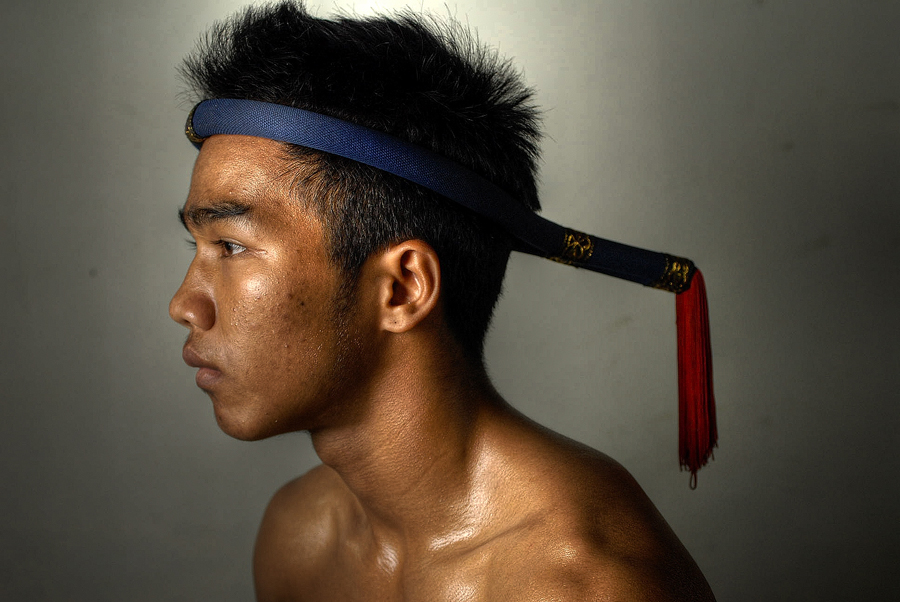At lookchaomaesaitong we do love kids and as we know local children love Muay Thai and especially love meeting foreigner fighter, we regularly organize privileged time with them...a good occasion for you to teach them Thai Boxing tricks. |
|
|
|
|
|
Definition
Muay Thai (Thai: มวยไทย, RTGS: Muai Thai, IPA: [mūɛj tʰāj]) is a martial
art from Thailand that uses stand-up striking along with various
clinching techniques.
It is similar to other Indochinese styles of kickboxing, namely pradal
serey from Cambodia, tomoi from Malaysia, lethwei from Myanmar and Muay
Lao from Laos.
Descended from muay boran, Muay Thai is Thailand's national sport.
The word muay derives from the Sanskrit mavya and Thai comes from the
word Tai.
Muay Thai is referred to as the "Art of Eight Limbs" or the
"Science Of Eight Limbs" because it makes use of punches, kicks, elbows
and knee strikes, thus using eight "points of contact", as opposed to
"two points" (fists) in Western boxing and "four points" (hands and
feet) used in sport-oriented martial arts.
A practitioner of Muay Thai is known as a nak muay. Western
practitioners are sometimes called nak muay farang meaning foreign
boxer.
Muay Thai Folklore
|
 |
| Nai Khanomtom |
The most popular folklore regarding muay boran is that of Nai Khanomtom.
At the time of the fall of the ancient Siam capital of Ayutthaya in 1767, the invading Burmese troops rounded up thousands of Thais and took them to Burma as prisoners. Among them were a large number of Thai kickboxers, who were taken to the city of Ava.
In 1774, in the Burmese city of Rangoon, the Burmese King Hsinbyushin (known in Thai as "King Mangra") decided to organize a seven-day, seven-night religious festival in honor of Buddha's relics. The festivities included many forms of entertainment, such as the costume plays called likay, comedies and farces, and sword-fighting matches. At one point, King Hsinbyushin wanted to see how muay boran would compare to the Burmese art Lethwei. Nai Khanomtom was selected to fight against the Burmese champion. The boxing ring was set up in front of the throne and Nai Khanomtom did a traditional Wai Kru pre-fight dance, to pay his respects to his teachers and ancestors, as well as the spectators, dancing around his opponent. This amazed and perplexed the Burmese people, who thought it was black magic. When the fight began, Nai Khanomtom charged out, using punches, kicks, elbows, and knees to pummel his opponent until he collapsed.
However the Burmese referee said the Burmese champion was too distracted by the dance, and declared the knockout invalid. The King then asked if Nai Khanomtom would fight nine other Burmese champions to prove himself. He agreed and fought them all, one after the other with no rest periods in between. His last opponent was a great kickboxing teacher from Rakhine. Nai Khanomtom mangled him by his kicks and no one else dared to challenge him.
King Mangra was so impressed that he allegedly remarked, "Every part of the Thai is blessed with venom. Even with his bare hands, he can fell nine or ten opponents. But his Lord was incompetent and lost the country to the enemy. If he would have been any good, there was no way the City of Ayutthaya would ever have fallen."
King Mangra granted Nai Khanomtom freedom along with either riches or two beautiful Burmese wives. Nai Khanomtom chose the wives as he said that money was easier to find. He then departed with his wives for Siam. Other variations of this story had him also winning the release of his fellow Thai prisoners. His feat is celebrated every March 17 as Boxer's Day or National Muay Boran Day in his honor and that of muay boran's.
Today, some have wrongly attributed the legend of Nai Khanomtom to King Naresuan, who was once taken by the Burmese. However, Nai Khanomtom and King Naresuan were almost two centuries apart.
|
| |
|
|
|
|
|
|
|
|
